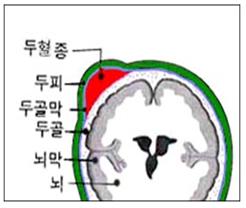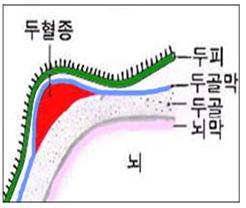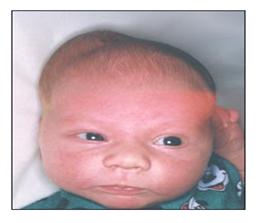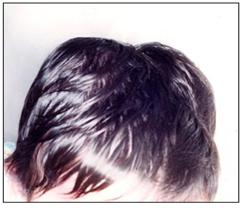신생아 두혈종, Cephalohematoma of newborn infants(Cephalohematomas in newborn infants/Neonatal cephalohematomas)
신생아의 두개골 (두골)의 바깥 표면과 그 두개골의 바깥 표면을 둘러싸고 있는 두개골 골막의 안쪽 면 사이에 있는 공간에 피가 괸 것을 신생아 두혈종이라고 한다.(그림 7~9 참조)
- 두개골은 8개의 두개골 조각으로 구성되어 있다.
- 즉 각각 한 개의 전두개골, 후두개골, 접형골, 사골과 2개의 두정골, 2개의 측두개골 총 8개의 두개골 조각으로 구성된다.
- 두혈종은 여러 개의 두개골 조각들 중 한 개의 두개골 조각에 국한되어 생긴다.
- 신생아 두혈종은 머리의 한쪽에 하나 생길 수도 있고 머리의 양쪽에 각각 하나씩 두 개가 동시 생길 수도 있다.
- 신생아 두혈종이 생긴 머리 부분이 큰 혹이 난 것처럼 부어오를 수 있다. 신생아 두혈종의 크기는 여러 가지다.

그림 8. 두개골의 맨 바깥 면과 두개골의 골막의 사이에 괸 피를 신생아 두혈종이라 한다.
Copyright ⓒ 2011 John Sangwon Lee, MD., FAAP

그림 9. 두개골의 맨 바깥 면과 두개골 골막 안쪽면의 사이에 괸 피를 신생아 두혈종이라 한다.
Copyright ⓒ 2011 John Sangwon Lee, MD., FAAP
| 신생아 두혈종의 원인 |
- 분만 중 산도에 가장 먼저 나온 아기의 머리의 일부가 산도에 눌릴 때 두개골의 맨 바깥 표면과 그 부분의 두개골을 둘러싸고 있는 두개골 골막(두골 골막) 사이에 있는 작은 혈관이 파열되고 출혈되어 그 사이에 피가 고여 두혈종이 생긴다.
- 자연분만, 난산, 또는 겸자분만으로 태어난 신생아에게 두혈종이 생겨 있는 것을 간혹 볼 수 있다.
- 아기의 머리가 분만 중 산도의 압력으로 심하게 압박받지 않고 태어난 신생아에게도 두혈종이 생길 수 있다.
- 피를 쉽게 흘릴 수 있는 전신 출혈성 질환이 있는 신생아에게도 두혈종이 생길 수 있다.
- 아주 작은 미숙 신생아로 태어날 때 태어나는 아기의 머리가 산도에 심하게 압박받지 않아도 갓 태어난 미숙신생아의 머리에 두혈종이 생길 수 있다.
| 신생아 두혈종의 증상 징후 |
- 신생아 두혈종은 출생 후 24시간 이내 나타날 수 있으나, 생후 2~3일 경 현저하게 나타난다.
- 신생아 두혈종은 머리의 가장 윗부분, 즉 우측 두정골 부위나 좌측 두정골 부위, 또는 양쪽 두정골 부위에 나타 날 수 있다. (사진 12 참고)
- 피가 조금 괴어 있는 신생아 두혈종은 밤알 크기만 하고 피가 많이 괴어 있는 신생아 두혈종은 달걀 크기만 하다.
- 신생아 두혈종의 바로 위에 있는 두피는 정상 두피의 색깔과 거의 같다.
- 신생아 두혈종을 손으로 살살 만지면 말랑말랑한 촉감이 있지만 아프지는 않다.
- 신생아 두혈종이 상당히 크면 갓 태어난 신생아의 전체 혈 양 중 상당한 양이 신생아 두혈종 속으로 출혈될 수 있고 그로 인해 신생아에게는 출혈성 빈혈이 생길 수 있다.
- 신생아 두혈종 속에 괸 혈액의 적혈구가 파괴되면서 빌리루빈이 비정상적으로 다량 생성될 수 있다. 그 빌리루빈이 혈액 속으로 흡수되면서 신생아 황달이 생길 수 있다.
- 신생아 두혈종의 25% 경미한 두개골 골절을 동반할 수 있다.
- 신생아 두혈종과 함께 생긴 경미한 두개골 골절은 대개 선상 두개골 골절이다.
- 이 때 생긴 두개골 골절의 대부분은 아무런 치료 없이 저절로 낫는다.

사진 10. 우측 머리에 생긴 신생아 두혈종.
Copyright ⓒ 2011 John Sangwon Lee, MD., FAAP

사진 11. 양측 머리에 생긴 신생아 두혈종.
Copyright ⓒ 2011 John Sangwon Lee, MD., FAAP

사진12.신생아 두혈종이 양쪽 두정골 부분에 생겨있다.
Copyright ⓒ 2011 John Sangwon Lee, MD., FAAP
| 신생아 두혈종의 진단 |
- 병력 증상 징후 진찰소견 등을 종합해서 이 병이 의심되면 두부 X선 사진 검사로 확진할 수 있다.
| 신생아 두혈종의 치료 |
- 국소 도포용 크림이나 연고를 발라 치료할 필요 없다.
- 신생아 두혈종은 생후 6주~3개월 정도 지나면 저절로 없어진다.
- 드물게 신생아 두혈종 속 피가 석회화될 수 있다. 거기에 혹 같이 단단하고 작은 석회화된 살덩어리가 얼마 동안 만져질 수 있다. 이것도 그 후 몇 개월 지나면 자연히 없어진다.
- 신생아 두혈종 내 괸 피를 주사바늘로 뽑거나 수술로 치료 할 필요도 없다.
Cephalohematomas in newborn infants/Neonatal cephalohematomas 신생아 두혈종
- The bleeding in the space between the outer surface of the newborn’s skull (head bone) and the inner surface of the cranial periosteum surrounding the outer surface of the skull is called neonatal cephalohematoma (see Figures 7-9).
- The skull consists of eight skull fragments.
- That is, each of the front skull, occipital skull, sphenoid bone, ethmoid bone and two parietal bones, and two temporal skulls are composed of a total of eight skull fragments.
- Cephalohematomas are confined to one of several skull fragments.
- Neonatal cephalohematomas may develop one on one side of the head or two concurrently, one on each side of the head. The head of the neonatal cephalohematoma may swell as if it were a large lump.
- Neonatal cephalohematomas vary in size.

Figure 8. The blood that bleeds between the outermost surface of the skull and the periosteum of the skull is called neonatal cephalohematoma. Copyright ⓒ 2011 John Sangwon Lee, MD., FAAP

Figure 9. The blood that bleeds between the outermost surface of the skull and the inner surface of the periosteum of the skull is called neonatal cephalohematoma. Copyright ⓒ 2011 John Sangwon Lee, MD., FAAP
Causes of neonatal cephalohematomas
- When a part of the baby’s head, which first appeared in the birth canal during delivery, is pressed against the birth canal, a small blood vessel between the outermost surface of the skull and the cranial periosteum surrounding the skull of that part ruptures and bleeds, causing blood between them.
- Cephalohematoma develops.
- Newborns born with spontaneous delivery, difficult labor, or forceps delivery can occasionally have cephalohematomas.
- Cephalohematomas can develop even in newborns whose head is not severely compressed by the pressure of the birth canal during delivery.
- Cephalohematomas can also develop in newborns with systemic bleeding disorders that can bleed easily.
- When born as a very small immature newborn baby, a head hematoma can develop on the head of a newborn immature newborn, even if the baby’s head is not severely pressed by the birth canal.
Symptoms, signs of neonatal cephalohematoma
- Neonatal cephalohematomas can appear within 24 hours after birth but appear remarkably around 2-3 days after birth.
- Neonatal cephalohematomas can appear in the uppermost part of the head, in the right or left parietal area, or in both parietal areas. (Refer to photo 12)
- A neonatal cephalohematoma with a little blood is the size of a chestnut, and a newborn cephalohematoma with a lot of blood is the size of an egg.
- The scalp directly above the neonatal cephalohematoma is almost the same color as the normal scalp.
- If you gently touch a newborn baby’s head hematoma with your hand, it has a soft touch, but it doesn’t hurt. If the neonatal cephalohematoma is very large, a significant amount of the newborn’s total blood volume can bleed into the neonatal cephalohematoma, which can lead to hemorrhagic anemia in the newborn.
- As red blood cells in the blood of the neonatal cephalohematoma are destroyed, abnormally large amounts of bilirubin can be produced.
- The absorption of the bilirubin into the blood can lead to neonatal jaundice. 25% of neonatal cephalohematomas can be accompanied by minor skull fractures. Minor skull fractures with neonatal cephalohematomas are usually linear skull fractures. Most of the fractures in the skull heal on their own without any treatment.

- Picture 10. Neonatal cephalohematoma on the right head. Copyright ⓒ 2011 John Sangwon Lee, MD., FAAP

- Photo 11. Neonatal cephalohematoma on both heads. Copyright ⓒ 2011 John Sangwon Lee, MD., FAAP

- Picture 12: Newborn cephalohematomas appear on both sides of the parietal bone. Copyright ⓒ 2011 John Sangwon Lee, MD., FAAP
Diagnosis of neonatal cephalohematoma
- If the disease is suspected by taking the medical history, symptoms, signs, examination findings, etc., it can be confirmed by a head x-ray examination.
Treatment of neonatal cephalohematoma
- There is no need to apply topical creams or ointments to treat.
- Neonatal cephalohematomas disappear on their own after 6 weeks to 3 months of age.
- Rarely, the blood in the neonatal cephalohematoma can become calcified.
- There, hard, small calcified flesh like humps can be touched for some time.
- This, too, disappears spontaneously after a few months.
- There is no need to aspirate the blood from the neonatal cephalohematoma with a needle or to treat it with surgery.
출처 및 참조 문헌
- NelsonTextbook of Pediatrics 22ND Ed
- The Harriet Lane Handbook 22ND Ed
- Growth and development of the children
- Red Book 32nd Ed 2021-2024
- Neonatal Resuscitation, American Academy Pediatrics
- www.drleepediatrics.com 제1권 소아청소년 응급 의료
- www.drleepediatrics.com 제2권 소아청소년 예방
- www.drleepediatrics.com 제3권 소아청소년 성장 발육 육아
- www.drleepediatrics.com 제4권 모유,모유수유, 이유
- www.drleepediatrics.com 제5권 인공영양, 우유, 이유식, 비타민, 미네랄, 단백질, 탄수화물, 지방
- www.drleepediatrics.com 제6권 신생아 성장 발육 육아 질병
- www.drleepediatrics.com제7권 소아청소년 감염병
- www.drleepediatrics.com제8권 소아청소년 호흡기 질환
- www.drleepediatrics.com제9권 소아청소년 소화기 질환
- www.drleepediatrics.com제10권. 소아청소년 신장 비뇨 생식기 질환
- www.drleepediatrics.com제11권. 소아청소년 심장 혈관계 질환
- www.drleepediatrics.com제12권. 소아청소년 신경 정신 질환, 행동 수면 문제
- www.drleepediatrics.com제13권. 소아청소년 혈액, 림프, 종양 질환
- www.drleepediatrics.com제14권. 소아청소년 내분비, 유전, 염색체, 대사, 희귀병
- www.drleepediatrics.com제15권. 소아청소년 알레르기, 자가 면역질환
- www.drleepediatrics.com제16권. 소아청소년 정형외과 질환
- www.drleepediatrics.com제17권. 소아청소년 피부 질환
- www.drleepediatrics.com제18권. 소아청소년 이비인후(귀 코 인두 후두) 질환
- www.drleepediatrics.com제19권. 소아청소년 안과 (눈)질환
- www.drleepediatrics.com 제20권 소아청소년 이 (치아)질환
- www.drleepediatrics.com 제21권 소아청소년 가정 학교 간호
- www.drleepediatrics.com 제22권 아들 딸 이렇게 사랑해 키우세요
- www.drleepediatrics.com 제23권 사춘기 아이들의 성장 발육 질병
- www.drleepediatrics.com 제24권 소아청소년 성교육
- www.drleepediatrics.com 제25권 임신, 분만, 출산, 신생아 돌보기
- Red book 29th-31st edition 2021
- Nelson Text Book of Pediatrics 19th- 21st Edition
- The Johns Hopkins Hospital, The Harriet Lane Handbook, 22nd edition
- 응급환자관리 정담미디어
- Pediatric Nutritional Handbook American Academy of Pediatrics
- 소아가정간호백과–부모도 반의사가 되어야 한다, 이상원 저
- The pregnancy Bible. By Joan stone, MD. Keith Eddleman, MD
- Neonatology Jeffrey J. Pomerance, C. Joan Richardson
- Preparation for Birth. Beverly Savage and Dianna Smith
- 임신에서 신생아 돌보기까지. 이상원
- Breastfeeding. by Ruth Lawrence and Robert Lawrence
- Sources and references on Growth, Development, Cares, and Diseases of Newborn Infants
- Emergency Medical Service for Children, By Ross Lab. May 1989. p.10
- Emergency care, Harvey Grant and Robert Murray
- Emergency Care Transportation of Sick and Injured American Academy of Orthopaedic Surgeons
- Emergency Pediatrics A Guide to Ambulatory Care, Roger M. Barkin, Peter Rosen
- Quick Reference To Pediatric Emergencies, Delmer J. Pascoe, M.D., Moses Grossman, M.D. with 26 contributors
- Neonatal resuscitation Ameican academy of pediatrics
- Pediatric Nutritional Handbook American Academy of Pediatrics
- Pediatric Resuscitation Pediatric Clinics of North America, Stephen M. Schexnayder, M.D.
-
Pediatric Critical Care, Pediatric Clinics of North America, James P. Orlowski, M.D.
-
Preparation for Birth. Beverly Savage and Dianna Smith
-
Infectious disease of children, Saul Krugman, Samuel L Katz, Ann A.
- 제4권 모유, 모유수유, 이유 참조문헌 및 출처
- 제5권 인공영양, 우유, 이유, 비타민, 단백질, 지방 탄수 화물 참조문헌 및 출처
- 제6권 신생아 성장발육 양호 질병 참조문헌 및 출처
- 소아과학 대한교과서
|
Copyright ⓒ 2015 John Sangwon Lee, MD., FAAP 미국 소아과 전문의, 한국 소아청소년과 전문의 이상원 저 “부모도 반의사가 되어야 한다”-내용은 여러분들의 의사로부터 얻은 정보와 진료를 대신할 수 없습니다. The information contained in this publication should not be used as a substitute for the medical care and advice of your doctor. There may be variations in treatment that your doctor may recommend based on individual facts and circumstances. “Parental education is the best medicine.” |